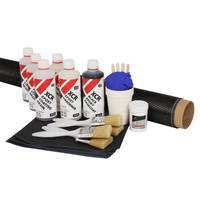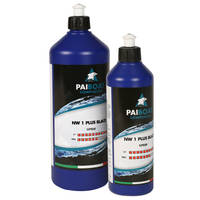Heb je hulp of advies nodig?+44 (0)1782 454499
PRODUCTEN GEBRUIKT IN DIT PROJECT
Hoewel dit niet per se een uitputtende lijst is, werden de volgende gereedschappen en materialen, geleverd door Easy Composites, in dit project gebruikt.
De hoeveelheid die hieronder wordt weergegeven, is de geschatte hoeveelheid die in het project wordt gebruikt, afgerond naar de dichtstbijzijnde beschikbare kitgrootte of hoeveelheid.
MATERIALEN & VERBRUIKSARTIKELEN
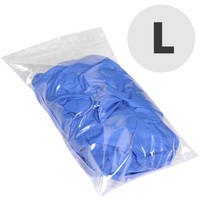
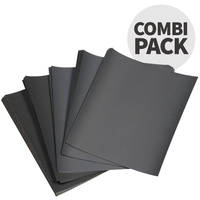
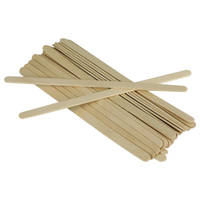
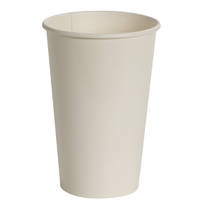
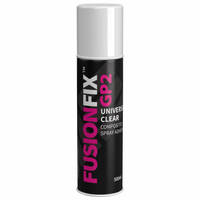
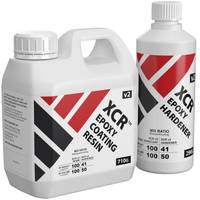
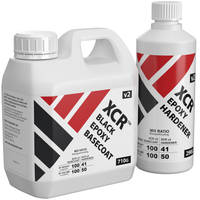
GEREEDSCHAP & UITRUSTING
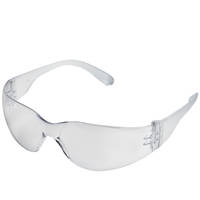
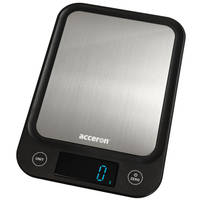
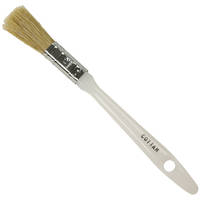
VERSTERKINGEN
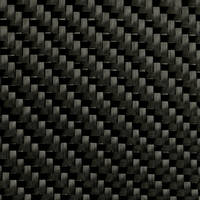
VIDEO HANDLEIDING
Bestaande Onderdelen met Koolstofvezel Bedekken - Koolstofvezel Skinning
Stap-voor-stap uitleg over het skinnen van koolstofvezel bij onze XCR Carbon Fibre Skinning Starter Kit. In de tutorial gebruiken we de kit om een laag echte koolstofvezel te 'villen' op een gebroken houten geweerkolf. Door de kolf te villen met koolstofvezel krijgt deze niet alleen een prachtige nieuwe koolstofvezelafwerking, maar wordt het onderdeel ook aanzienlijk sterker.
Download de bijbehorende XCR Carbon Fibre Skinning Kit Instructions PDF bij deze video tutorial.
Voordat je aan een skinningproject begint, moet je eerst deze videotutorial bekijken, de instructiehandleiding lezen en de timing voor je skinningproject plannen - timing is de sleutel!
UITSPLITSING TUTORIAL
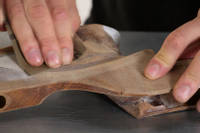
1. Toets het oppervlak van het onderdeel
Als het onderdeel vettig of bijzonder vuil is, was het dan in een sopje en droog het goed af voordat je verder gaat. Kras het oppervlak van het onderdeel zo grondig mogelijk met schuurpapier 120 korrel. Let vooral op bij het afschuren van kunststof onderdelen (zoals ABS interieurdelen) om ervoor te zorgen dat het hele oppervlak goed wordt afgeschuurd met het schuurpapier.
Verwijder na het aanbrengen van de spiebaan alle stofsporen met een microvezeldoek of een tacker.
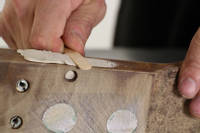
2. Blank-off of vul alle gaten
In veel gevallen zal je onderdeel geen gebieden hebben die je moet afdekken voordat je gaat skin, maar als dat wel het geval is, moet je dat nu doen met boetseerklei (plasticine). maar als dat wel het geval is, moet je dat nu doen met boetseerklei (Plasticine). We raden af om composietplamuur voor dit doel te gebruiken, omdat de was kan werken als een losmiddel op de omliggende gebieden, waardoor de hechting tussen de basecoat en het onderdeel.
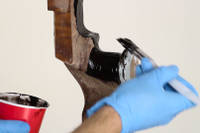
3. Basislak mengen en aanbrengen
Meng een hoeveelheid basecoat die geschikt is voor de grootte van het deel dat je gaat lakken. Om je te helpen bij het berekenen van de juiste hoeveelheid basecoat, heb je ongeveer 330 g basecoat (en verharder samen) nodig om 1 m² oppervlak te bedekken - dit betekent dat als je de hele 0,3 m² carbon gebruikt die in de kleine skiningset zit, je ongeveer 100 g basecoat moet mengen; als je de helft van deze hoeveelheid stof gebruikt, heb je slechts 50 g gemengde basecoat nodig.
Als je twijfelt; meng te weinig - je kunt altijd meer basecoat mengen. Hetzelfde geldt voor de blanke hars die in latere stadia wordt gebruikt. Gebruik de tabel aan het begin van deze handleiding voor een aantal handige mengverhoudingen. Voordat je de basecoat giet, moet je de fles goed schudden om eventueel neergeslagen pigment te verspreiden.
Breng de basecoat aan over het hele oppervlak van het te skin deel. Probeer de laag de laag zo glad en gelijkmatig mogelijk aan te brengen. Je zult merken dat het zware zwarte pigment in de basecoat voldoende is om de kleur van het onderliggende deel zwart te maken. maar in extreme omstandigheden kun je merken dat na het aanbrengen van de basecoat de kleur van het onderdeel nog zichtbaar is. van het onderdeel nog zichtbaar is. In deze situatie moet je ongeveer 2 uur wachten (bij 20°C) wachten tot de eerste laag basecoat is uitgehard voordat je een tweede laag basecoat aanbrengt, voordat je verder gaat. basecoat aan te brengen, voordat je verder gaat.
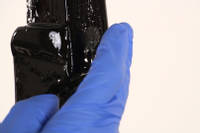
4. Wacht tot de basecoat de ideale hechting heeft bereikt
De timing van deze volgende stap is erg belangrijk. Je moet wachten tot de basecoat begint uit te harden (zodat het begint in te dikken en niet langer 'nat' is), maar niet niet te ver laten uitharden zodat het zijn 'tack' verliest. Bij 20°C ligt dit punt ergens tussen 2-3 uur, maar je moet het blijven controleren. Gebruik een gehandschoende vinger om de basecoat te 'deppen' - het moet plakkerig aanvoelen en moet kunnen worden ingedrukt, maar een lichte aanraking met je vinger zou geen hars weg moeten brengen. Houd je vinger even op de hars (niet aan te raden op kritieke plekken) zal waarschijnlijk nog steeds wat hars wegbrengen in dit stadium. in dit stadium.
Als de basecoat op dit ideale hechtingsniveau is, moet je meteen doorgaan met naar de volgende stap. Als je merkt dat je de ideale kleefkracht niet hebt bereikt en dat de basecoat niet meer kleverig is, is het vaak mogelijk om de kleverigheid te herstellen door de basecoat voorzichtig te verwarmen met een heteluchtpistool. door de basecoat voorzichtig te verwarmen met een heteluchtpistool, maar dit moet alleen als gebruikt worden als laatste redmiddel.
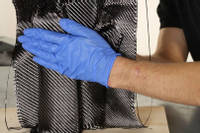
5. Plak koolstofweefsel op basecoat
Als de basislak de ideale kleefkracht heeft (vorige sectie), zou deze de perfecte kleefkracht moeten hebben voor de koolstofvezelstof. De beste manier om de koolstofvezel op het onderdeel te leggen varieert van vorm tot vorm, maar een goede algemene regel is om te beginnen bij de belangrijkste oppervlakken (vaak de (vaak de grootste of meest zichtbare) en van daaruit verder te werken.
Als je onderdeel openingen heeft (zoals uitsparingen voor wijzerplaten van instrumenten) dan is het meestal het beste om het carbon recht over het gat te leggen en het pas te openen nadat de eerste laag doorzichtige hars is aangebracht. Hetzelfde geldt voor de randen van je onderdeel waar het meestal het beste is om het hangende carbon recht over de randen van je onderdeel te leggen en dan pas terug te snijden nadat de eerste laag doorzichtige hars is aangebracht. Het is zelden aan te raden om het carbon rond de achterkant van een onderdeel te wikkelen omdat dit vaak ballooning of voiding kan veroorzaken aan de afgeknipte rand van een onderdeel.
Voor complexe onderdelen kun je overwegen om het oppervlak in meerdere delen te voltooien. Met de nodige vaardigheid kunnen dergelijke verbindingslijnen heel discreet worden aangebracht, vooral op hoeken waar ze bijna onmogelijk te zien zijn. Als je nette verbindingslijnen op je onderdeel moet maken, heb je een epoxy-compatibele spuitlijm nodig zoals FusionFix™ van Easy Composites.
Laten uitharden. Laat de basecoat minstens 2 uur uitharden voordat je verder gaat. Het is prima om het project nu zo lang te laten liggen als je wilt voordat je verder gaat.
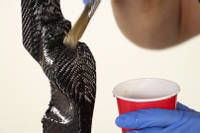
6. Meng en breng de eerste transparante laag aan
Voordat je de 1e laag doorzichtige XCR Coatinghars aanbrengt, controleer je het onderdeel op verdwaalde of losse koolstofvezels. Als die er zijn, verwijder of knip ze dan weg zodat de randen en verbindingen redelijk netjes zijn voordat je verder gaat.
Voor de 1e laag hars moet je iets meer hars mengen dan je voor de volgende lagen nodig hebt, omdat er een beetje extra hars nodig is om de droge koolstofvezel nat te maken. Over het algemeen heb je voor deze fase ongeveer evenveel hars nodig als voor de basislak van het onderdeel.
Volg de 3:1 mengverhouding zo nauwkeurig mogelijk, weeg een geschikte hoeveelheid hars en verharder af en meng zorgvuldig en grondig. Breng een gelijkmatige laag aan over het hele oppervlak van het onderdeel en zorg ervoor dat je de droge koolstofvezel volledig nat maakt. Het is nooit de bedoeling om een dikke laag hars aan te brengen; in plaats daarvan wordt de dikte opgebouwd uit een aantal dunne lagen. Als je merkt dat er te veel hars van je onderdeel afloopt, kan dit erop wijzen dat je de hars te dik aanbrengt, maar bij verticale oppervlakken zal er altijd een bepaalde hoeveelheid afvloeien.
Laat de eerste blanke lak minstens 8 uur uitharden voordat je verder gaat. Het is volkomen veilig om het project nu zo lang te laten liggen als je wilt voordat je verder gaat.
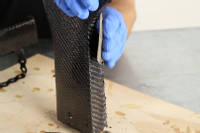
7. Di-nib en schuur het oppervlak (korrel 120)
Als de 1e laag hars is uitgehard tot een harde, schuurbare afwerking, gebruik dan een schuurpapiertje met korrel 120 om eventuele puntjes (vaak veroorzaakt door losse vezels aan de rand van voeglijnen die overeind staan), druppels of andere hoge plekken te verwijderen.
Vervolgens moet je het hele oppervlak van het onderdeel bewerken met meer korrel 120 zodat de volgende laag hars zich erop kan hechten. Hoewel je in dit stadium licht kunt 'vlakken' (om hoge of lage plekken in de hars te verwijderen), moet je oppassen dat je niet door de koolstofvezel heen breekt. Als je ziet dat het schuurstof zwart wordt, moet je meteen stoppen.
Je kunt nu meteen doorgaan naar de volgende stap, of het project in dit stadium zo lang laten staan als je wilt.
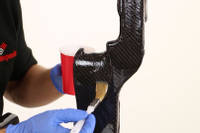
8. Meng en breng drie extra transparante lagen aan
De hoofddikte van heldere hars moet nu worden opgebouwd door nog 3 lagen heldere XCR Coating hars aan te brengen op het oppervlak van het onderdeel, waarbij elke laag hars gedeeltelijk moet uitharden voordat de volgende laag wordt aangebracht.
Het juiste moment om de volgende laag hars toe te voegen is wanneer de vorige laag begint op te stijven, maar nog wel enige kleverigheid heeft die je kunt testen met een gehandschoende vinger op dezelfde manier als voor de basecoat. Bij 20°C betekent dit ongeveer 2 uur wachten tussen elke laag doorzichtige hars.
Je moet de vorige harslaag NIET laten uitharden tot voorbij de 'tack'-fase voordat je de volgende harslaag aanbrengt. Als je dat wel doet, kan de nieuwe harslaag niet goed hechten aan de vorige laag en kan deze delamineren. Je zult ook merken dat de nieuwe harslaag zichtbaar zal 'wegkijken' van de vorige laag als deze niet meer in het hechtstadium is.
Als je per ongeluk een laag hars te ver laat uitharden, zodat deze niet meer in het 'hechtingsstadium' is, moet je niet proberen de volgende laag hars aan te brengen zonder eerst de vorige laag een vergevorderd stadium van uitharding te laten bereiken (ongeveer 8 uur) en vervolgens het oppervlak helemaal af te strijken met schuurpapier korrel 120.
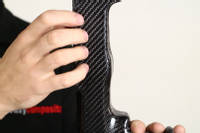
9. Laten uitharden
Nadat je de 3e laag doorzichtige xcr in deze sessie hebt aangebracht (wat de 4e laag in totaal zou zijn) moet je het onderdeel volledig laten uitharden, wat bij 20°C minstens 8 uur zou duren, maar je kunt het in dit stadium zo lang laten liggen als je wilt.
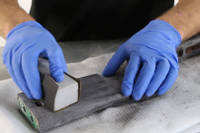
10. Vlak het oppervlak (120 - 240 korrel)
Als de heldere harslagen zijn uitgehard tot een volledig harde afwerking, is er nu genoeg harsdikte om het oppervlak goed vlak te maken.
Vlakmaken is het proces waarbij het oppervlak van het onderdeel wordt gladgewreven om eventuele rimpels of 'wiebels' van het oppervlak te verwijderen. De kwaliteit van het vlakmaken bepaalt hoe professioneel het oppervlak van het afgewerkte onderdeel zal zijn, dus neem de tijd in dit stadium en probeer het oppervlak zo vlak mogelijk te krijgen.
Begin met het schuurpapier met korrel 120 en droog te schuren. Het wordt aangeraden om het schuurpapier om een zachte maar vlakke pad (zoals een stuk schuimrubber) te wikkelen tijdens het schuren om een vlakke afwerking te verkrijgen. Dit geldt ook voor de fijnere schuurpapierkwaliteiten als je daarmee verder gaat.
In sommige gevallen kun je het oppervlak niet goed vlak krijgen zonder door de koolstof eronder heen te breken. Als deze situatie zich voordoet, moet je stoppen met vlakken, alle schuurstofresten verwijderen en een of meer extra lagen hars aanbrengen door terug te gaan naar en verder te gaan vanaf stap 10.
Als je tevreden bent met de vlakheid van het oppervlak met korrel 120, ga dan verder met korrel 240. Ook in dit stadium raden we aan om nat te schuren. Zorg ervoor dat alle krassen van het 120-korrelige papier verwijderd zijn door het 240-korrelige papier voordat je verder gaat met de volgende stap.
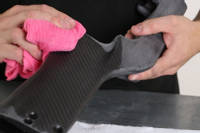
11. Reinig het onderdeel grondig
Voordat je de laatste laag doorzichtige hars aanbrengt, is het heel belangrijk om al het schuurstof van het oppervlak van het onderdeel te verwijderen, omdat stof dat achterblijft op het oppervlak wanneer de laatste laag hars wordt aangebracht, de hars kan verontreinigen en zichtbaar zal zijn in de uiteindelijke afwerking. Dit kan worden gedaan met een kleefdoek, microvezeldoek of door het onderdeel in een mild sopje te wassen. Zorg er in alle gevallen voor dat het onderdeel volledig gedroogd is voordat je verder gaat.
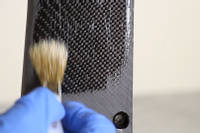
12. Breng de laatste blanke laklaag van XCR aan.
Het is nu tijd om de laatste laag doorzichtige XCR hars aan te brengen. Meng en breng de hars op dezelfde manier aan als de vorige doorzichtige XCR lagen.
De laatste laag hars hoeft maar heel dun te worden aangebracht, bijna alsof je een vernis of lak op het onderdeel aanbrengt. Het gladde oppervlak eronder moet het mogelijk maken om een gladde, egale glanzende afwerking te krijgen die er goed uitziet zelfs voordat het gevlakt en gepolijst is.
Omdat dit de laatste laag is, is het belangrijker dan ooit om ervoor te zorgen dat je de hars nauwkeurig afweegt en grondig mengt. Onjuist gemengde hars resulteert in plakkerige of streperige plekken op het uiteindelijke oppervlak van het onderdeel. Laat het onderdeel nu in een vergevorderd stadium uitharden. Bij 20°C duurt dit minstens 8 uur, maar hoe langer je wacht hoe beter, omdat het onderdeel dan meer van zijn uiteindelijke hardheid kan ontwikkelen.
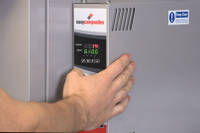
13. Optionele nabehandeling
Als de onderdelen die je skin waarschijnlijk tijdens het gebruik zullen worden blootgesteld aan hoge temperaturen, is het raadzaam om het gevilde onderdeel na te harden om een volledige uitharding te bereiken en ook de temperatuurstabiliteit van de uitgeharde hars te verhogen. Als je dit niet doet, bestaat het risico dat wanneer de onderdelen worden blootgesteld aan deze hogere temperaturen de hars zachter wordt en iets 'zakt', waardoor de textuur van het koolstofweefsel 'doorprint' naar het oppervlak.
Voorbeelden van omgevingen met hoge temperaturen zijn buitenpanelen van voertuigen en binnenbekleding van voertuigen, die beide temperaturen van meer dan 70°C kunnen bereiken wanneer ze aan de hete zomerzon worden blootgesteld. Om een gevild onderdeel 'na te harden', moet het minstens 6 uur in een oven van 60°C worden geplaatst en vervolgens afkoelen.
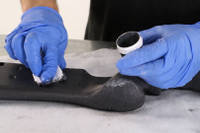
14. Vlak (korrel 400 - 1200) en polijsten
De laatste stap in het proces is het vlakschuren en polijsten van het uiteindelijke harsoppervlak tot volledige glans. Begin met schuurpapier korrel 400 en schuur het oppervlak nat tot een vlakke, gladde afwerking. Als je tevreden bent dat er geen hoge of lage vlekken zijn, veeg je het oppervlak af, ververs je het water en ga je verder met de volgende korrel. Ga verder met schuurpapier korrel 800 en vervolgens korrel 1200, waarbij u ervoor zorgt dat u het oppervlak schoonveegt en het water ververst tussen elke korrel. Zorg ervoor dat er geen krassen van de vorige korrel meer zichtbaar zijn voordat je naar de volgende korrel gaat. Als je klaar bent met het vlakschuren met korrel 1200, veeg dan grondig na.
De NW1 Black Super Cutting Compound die bij de Skinning Starter Kit wordt geleverd en ook apart verkrijgbaar is bij Easy Composites , moet worden gebruikt om het gevilde onderdeel te polijsten van een gladde maar satijnachtige afwerking met korrel 1200 tot een volledige glans. Het NW1 polijstmiddel kan met de hand of met een polijstpad en polijstmachine worden gebruikt. Indien beschikbaar zal een elektrische polijstmachine waarschijnlijk veel sneller zijn dan polijsten met de hand.
DISCUSSIE (33)
Laat het ons weten als je vragen of opmerkingen hebt over deze videotutorial.
LAAT EEN OPMERKING OF VRAAG ACHTER
PRODUCTEN GEBRUIKT IN DIT PROJECT
Hoewel dit niet per se een uitputtende lijst is, werden de volgende gereedschappen en materialen, geleverd door Easy Composites, in dit project gebruikt.
De hoeveelheid die hieronder wordt weergegeven, is de geschatte hoeveelheid die in het project wordt gebruikt, afgerond naar de dichtstbijzijnde beschikbare kitgrootte of hoeveelheid.
MATERIALEN & VERBRUIKSARTIKELEN







GEREEDSCHAP & UITRUSTING



VERSTERKINGEN

DISCUSSIE (33)
Laat het ons weten als je vragen of opmerkingen hebt over deze videotutorial.
LAAT EEN OPMERKING OF VRAAG ACHTER
100% BEVEILIGD
BETALINGSMETHODEN
Easy Composites EU B.V., geregistreerd in Nederland 73601195. Alle inhoud auteursrechtelijk beschermd (C) Easy Composites Ltd, 2025. Alle rechten voorbehouden.
